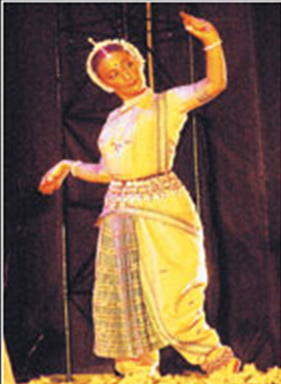Odissi
This is a collection of articles archived for the excellence of their content. Readers will be able to edit existing articles and post new articles directly |
An ode to Odissi
By Madeeha Syed
They arrived armed with cherubic smiles on heavily done-up faces and costumes that aimed to mimic the styles and fashion of ancient South Asia. They took their places on stage, and with the light shifting reflections on their faces, they showed different positions employed in Odissi — the most ancient of classical dance forms.
While a multimedia presentation gave the names and explained the concepts and histories behind each position, the little dancers, all of them students of Sadia Khan, alternated their hands, expressions and bodies to conform to the position being explained. For example, during the Khumba Baitha (meditative position), they would sit with knees bent, back perfectly straight and hands on either side of their knees in a perfect ancient meditative position.
Sadia Khan, who has been a student and teacher of Odissi for over a decade, recently hosted a complete Odissi performance at the Finance and Trade Centre (FTC). She has previously remained a student of none other than Sheema Kirmani and left for Delhi in 2000 to further her knowledge and skill in this art form under the patronage of Srimati Madhavi Mudgal and graduated from the Gandharva Mahavidyalaya with a first division in Odissi. She is currently teaching classical dance and theatre at The National Academy of Performing Arts (NAPA) and The Centre for Advanced Studies.
Following the multimedia performance was a recital titled Mangalacharan, a traditional introductory piece performed in Odissi. Sadia's little students came equipped with flowers and paid their respects to the gods, gurus and the audience. The dance was simple but it was amusing to note that the little dancers tried very hard to maintain their balance during one of the more difficult standing positions.
The way Sadia elaborated upon the poem by dexterously using her hands to depict the moon, the lotuses and the characters’ story was much more interesting to watch than the dance itself
Sadia’s entry on stage as a dancer came with a composition titled Jagannatha Ashtakam. She entered coyly through the white screen on the left side of the stage, which depicted her silhouette clearly, carrying flowers in her hand. The sound of the bells from her ghungru resonated clearly in the auditorium. What followed were a series of dance postures that had previously been explained, coupled with expressions depicting the mood of the composition being rendered as a dance. This was entertaining at first; however, too much of it, as it came in the following compositions, made it somewhat monotonous.
A composition which did stand out was the Madahave Ma Kuru, based on a 12th century poem titled The Gita Govinda by Jayadeva. Translated verses from the poem in English appeared on the screen before it was performed, and Sadia came on stage to explain what it was about. Using a series of hand movements, no doubt employed while performing an Odissi dance, she explained the story of Radha and Krishna and their love tussle regarding Krishna’s unfaithful behaviour and how Radha’s friend tried to help her overcome her feelings of anger and hurt.
The way Sadia elaborated upon the poem by dexterously using her hands to depict the moon, the lotuses and the characters’ story was much more interesting to watch than the dance itself. The absence of other dancers to fill in the roles of Krishna and Radha’s friend was sorely felt and I had to try hard and use my imagination as to what must have been going on around Radha while Sadia pranced about on stage playing her role. The final dance sequence was about the dancer merging in with the dance. The performance was full of energy, which made it slightly better then the ones preceding it.
One must keep in mind that Odissi is not exactly a very popular dance genre in Pakistan; and to appreciate it, an understanding of the culture and the mythology behind most of the dances is required. Even though the evening started off well and was a welcome change from the regular Kathak or Bharatnatyam dance recitals that are somewhat the norm, one felt it dragged a tad longer than it should have. Hopefully, over time, Odissi will grow on all of us enough for us to appreciate it as much as we do the other classical dance forms.
